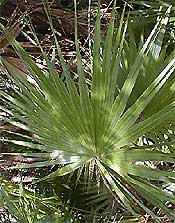Saturday, August 28, 2004
Transplanted palms
 When we first moved in about two years ago, we were awed by the gorgeous view but also a bit daunted by the work that needed to be done inside. The yard we felt could take care of itself so we could concentrate on replacing the kitchen and removing old carpet. There were a couple of volunteer palms by the garage wall and in the blowout area under the house, but we agreed that they would not grow so quickly that we needed to be worried. Fast forward two years later. We have been working on both the inside and outside of our home as we can. The gardens are looking better all the time and we have added a pool to the backyard. The volunteer palms, however, have reached a point where we agreed it was time to relocate them.
When we first moved in about two years ago, we were awed by the gorgeous view but also a bit daunted by the work that needed to be done inside. The yard we felt could take care of itself so we could concentrate on replacing the kitchen and removing old carpet. There were a couple of volunteer palms by the garage wall and in the blowout area under the house, but we agreed that they would not grow so quickly that we needed to be worried. Fast forward two years later. We have been working on both the inside and outside of our home as we can. The gardens are looking better all the time and we have added a pool to the backyard. The volunteer palms, however, have reached a point where we agreed it was time to relocate them.
Saturday dawned hot, humid and sunny and we decided it was time to move the palms. Armed with shovels and water, we started digging. The first palm was about 4 feet tall and almost as wide in expanse. It took my husband about 1/2 hour to dig around it without damaging roots. Together we rocked it until it was easily removed. We decided we wanted it in the corner of the yard where it would get roughly the same exposure, dug a hole, and placed it gently in its new home. The second and smaller palm was right at the garage wall, so we needed to be a bit more careful in its removal. The best place for that baby was in a huge pot we had placed on a step near the pool. We carefully dug that palm out and placed it in its pot, then watered both thoroughly.
A week later both are doing well, one small brown leaf on the bigger palm and none on the smaller so I think they are adapting to their move. Now comes the time for identification. I was under the impression that these palms were sabal palms, or more commonly referred to as cabbage palmettos. They are actually acoelorrhaphe wrightii paurotis palms or fan palms. The palms are very similar in appearance. The cabbage palmetto is the Florida state tree, growing 60-80 feet in height and tolerant of many conditions including salt. The fan palm, also widely identified as a saw cabbage palm, is a native of the Florida Everglades, has good salt tolerance but only grows about 30-40 feet in height. The only other difference than height is that the fan palm is clump-forming meaning that it is multi-stemmed. It is often used to soften corners or fill spaces along ponds. Anyway, the long and short of it, so to speak, is that the palms are identified and are doing well in their first week of relocation. We're keeping a close eye on them and look forward to sharing their progress as the summer/fall progresses. Happy Florida Gardening.
Comments:
Post a Comment

This work is licensed under a Creative Commons License.
Thanks to Andrew Stenning who contributed the photograph for our masthead


